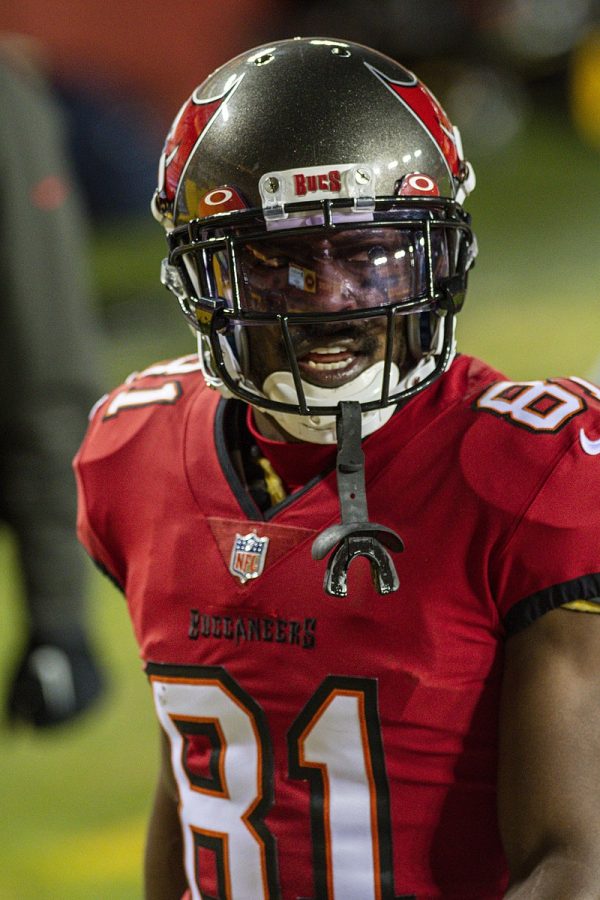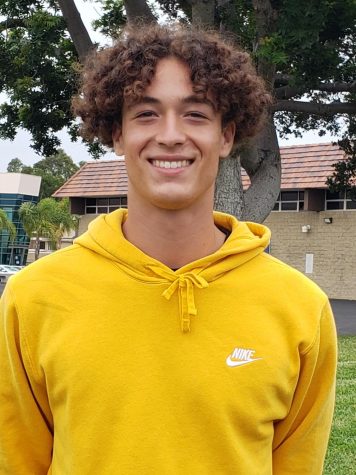Antonio Brown Storms Off Field. What Caused it?
Image used under copy right free license. From the Washington Football Team vs Tampa Bay Buccaneers at FedEx Field, Landover, Maryland.
February 4, 2022
On January 2nd, Tampa Bay Buccaneers seven-time pro bowl wide receiver Antonio Brown stormed off the field at MetLife Stadium against the New York Jets.
This bizarre exit happened late in the third quarter as Brown stripped his pads and undershirt, eventually throwing his gloves into the stands while waving goodbye to the Jets crowd. Many questions have been brought up as to why he did this.
The conflict was revealed to boil down to a dispute between Bucs Head Coach Bruce Arians and Brown. Per reports, Arians wanted Brown on the field, despite Brown claiming he was too injured to play. In the postgame interview, Arians said that Brown “is no longer a Buc.” After this statement, Brown went on to defend himself, stating that he had a lingering ankle injury, with MRIs revealing “broken bone fragments, a ligament torn from the bone and cartilage loss,” according to ESPN.
Brown then released personal texts with Arians from December 30th and January 1st, revealing that Arians knew about the lingering injury. Brown had missed eight weeks due to the injury and faking his vaccination.
While this was going on in the background, Arians stated that he had no recollection of the injury bothering him during practice. He even noted that Brown did not talk to any medical staff or trainers before telling Arians he couldn’t continue playing, clearly breaking protocol.
Brown would be officially cut from the team that following Thursday. Arians later said that his storming off the field wasn’t because of the injury, but rather because he was mad he wasn’t getting the ball on the field.
Brown had a $3.1 million contract that included a $2 million signing bonus, another $1.3 million in guarantees and a total of $3.55 million in incentives for reaching specific performance benchmarks. During the game against the Jets, Brown was reaching for a $1 million bonus split between getting 55 more receiving yards, one more receiving touchdown and eight more catches.
Recently, Antonio Brown and his agent, Sean Burstyn, appeared on HBO’s “Real Sport with Bryant Gumbel.” In the interview, Brown and Burstyn revealed they would be filing a defamation lawsuit worth “a lot of money” on the grounds of the Buccaneers organization accusing Brown of being mentally unfit to do his job. It was later revealed that the Buccaneers offered Brown $200,000 in mental health help.
In Gumbel’s interview, Brown stated that the biggest issue was the team trying to bribe him to go to the “crazy house.” He later said that he doesn’t need mental health help because he has “mental wealth,” as Brown put it.
Antonio Brown is misunderstood. He is also ridiculed to such a degree that he is dehumanized by some media members who are very critical of him. As people, we cannot wholly understand somebody’s thought process unless we are that person. Trying to understand what Antonio Brown thinks is an impossible task, but there are theories into why some of his actions seem so irrational to us.
A popular theory is that Brown’s illness is related to Chronic Traumatic Encephalopathy (CTE), the progressive degeneration of the brain caused by constant head trauma and concussions.
This theory gained traction due to revelations from a separate case; Aaron Hernandez. Hernandez, a former NFL player, was a murderer who killed two people and later committed suicide in prison after being acquitted of the second charge. His case brought so much attention because he was a famous player, reminiscent of the O.J. Simpson case. Hernandez’s post-mortem brain scans revealed that he had stage 3 CTE, which is extremely rare at such a young age. For context, Hernandez died at 27, and Brown is currently 33.
I am not saying that Brown is more insane than Hernandez was or will commit acts more atrocious than Hernandez. There are far too many external factors—such as position, sexuality, developmental years, and life experiences—to make a definite comparison. Instead, I believe that CTE is a factor in the deteriorating mental health of athletes, especially NFL players.
The sad truth is that there is no clear-cut solution to this issue. It is challenging to force a person to get mental health aid, even if we consider it ethical. Antonio Brown is his own person, an agent in charge of his own actions. We will never truly know what is going on in his head, but I know one thing for sure: Brown needs help, but is in denial. Do I think Arians could have treated Brown more humanely, understood Brown’s stance and even been honest about his knowledge with his injury? Yes. Does Brown need to reflect on his actions and consider why the world is against him? Yes.
Antonio Brown has proven to be right on many occasions, even when he treats the situation horribly and in an unprofessional manner. I understand Brown’s emotions and frustrations, but there are better ways to go about things. Both sides are in the wrong. I hope the Buccaneers, as an organization, have found where they were wrong in the handling of Brown’s affairs. I also hope Brown will do what is best for him and prove that he is correct, but misunderstood in his actions and statements.





